Swimming with whale sharks in the Philippines offers an extraordinary opportunity to encounter these gentle giants up close, in their natural habitat. The Philippines boasts some of the world’s richest marine biodiversity, making it an ideal destination for those seeking unique underwater experiences. Among the most awe-inspiring activities available to both locals and tourists alike is the chance to swim alongside the largest fish in the sea – the whale shark, or “Butanding” as it is known locally.
>> Book This Adventure Here <<
Swimming With Whale Sharks Video
Table of Contents
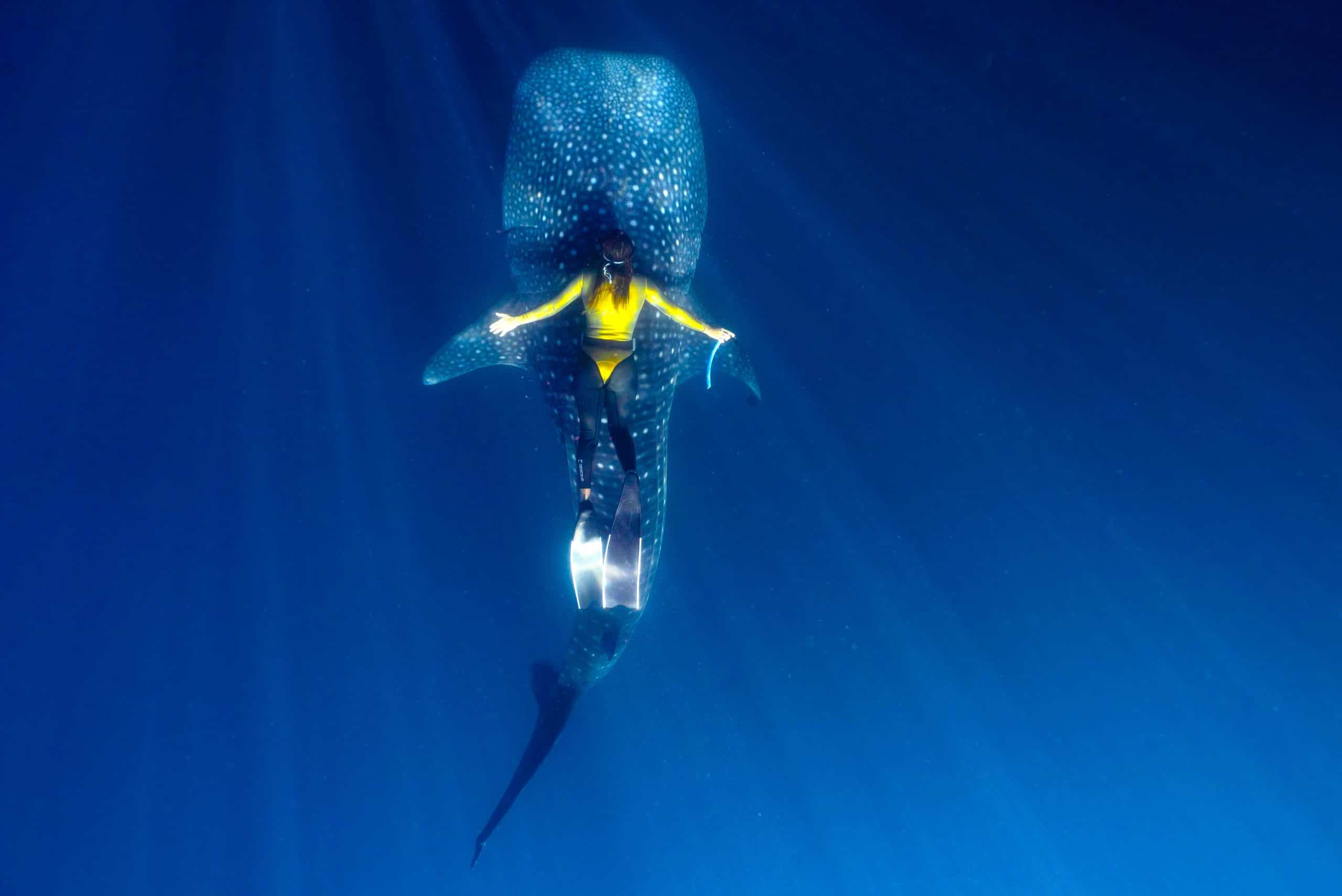
Top 10 Tips for Swimming With Whale Sharks
Swimming with whale sharks is an unforgettable experience that brings you face-to-face with one of nature’s most majestic creatures. To ensure that both you and the whale sharks have a safe and respectful encounter, here are the top 10 tips to keep in mind:
1. Choose a Responsible Tour Operator
Research and select a tour operator committed to ethical and sustainable practices. Look for those with good reviews that emphasize respect for wildlife and the environment.
2. Listen Carefully to the Briefing
Pay attention to the pre-swim briefing. It’s essential for understanding how to interact with whale sharks responsibly, including keeping a safe distance and not touching them.
3. Use Eco-Friendly Sunscreen
Protect yourself and the marine environment by using reef-safe sunscreen. Chemicals found in traditional sunscreens can harm marine life.
4. Keep a Respectful Distance
Maintain a safe distance from the whale sharks, usually at least 3 meters (about 10 feet) away from their body and 4 meters (about 13 feet) from the tail. This helps prevent stress to the animals and accidental injury to swimmers.
5. Don’t Touch the Whale Sharks
Resist the urge to touch the whale sharks. Contact with human hands can remove the protective mucous layer on their skin, making them susceptible to infections.
6. Move Slowly and Calmly
Sudden movements can startle whale sharks and other marine life. Move slowly and gracefully in the water to ensure a peaceful experience for everyone.
7. Keep the Ocean Clean
Do not leave any trash behind. Marine debris can be harmful to whale sharks and other sea creatures.
8. Don’t Use Flash Photography
If you’re taking pictures, avoid using flash as it can disturb the whale sharks. Most underwater cameras and GoPros work well in natural light.
9. Stay Hydrated and Protected
The sun can be intense, and staying in the water for extended periods can lead to dehydration and sunburn. Drink plenty of water and wear protective clothing if necessary.
10. Reflect on the Experience
After swimming with whale sharks, take the time to reflect on the encounter. Consider supporting marine conservation efforts to protect whale sharks and their habitat for future generations.
Following these tips ensures a memorable and respectful encounter with whale sharks, allowing these gentle giants to continue their peaceful existence in the oceans.
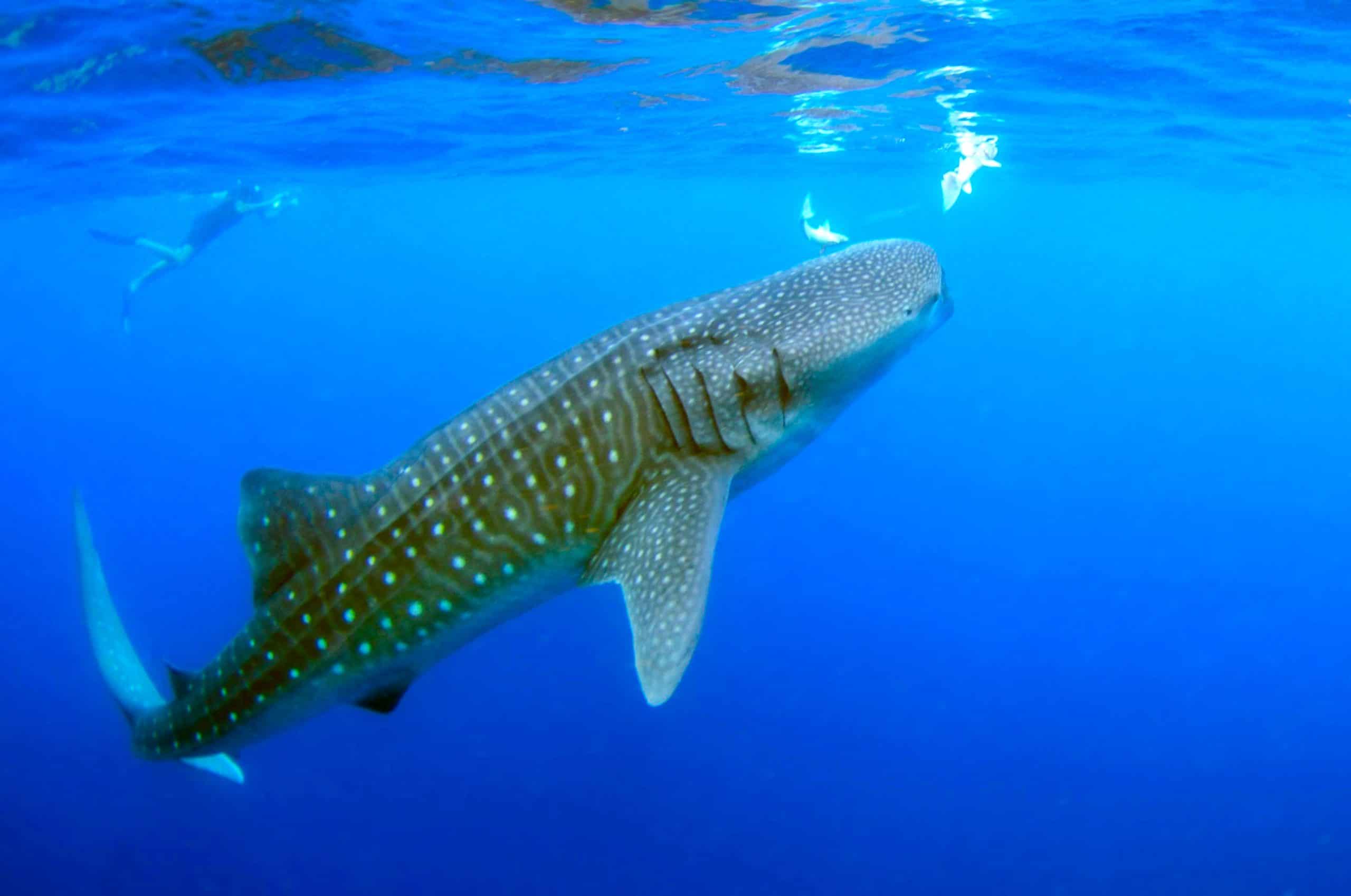
Introduction to Swimming With Whale Sharks
The coastal waters of the Philippines serve as a feeding ground for these majestic creatures, particularly in areas like Oslob, Cebu, Donsol in Sorsogon, and occasionally in other parts of the country. These spots have gained international fame for their accessibility to whale sharks, attracting adventurers, marine biologists, and conservationists from all corners of the globe.
This introduction to swimming with whale sharks in the Philippines isn’t just about the thrill of the encounter. It’s also a call to engage with these magnificent animals responsibly and sustainably. The experience underscores the Philippines’ commitment to marine conservation, aiming to protect these gentle giants while allowing people to marvel at their grace and beauty. As visitors immerse themselves in the crystal-clear waters, coming face-to-face with whale sharks, they are reminded of the delicate balance of marine ecosystems and the importance of our role in preserving them.
In embarking on this adventure, swimmers are encouraged to adhere to guidelines that ensure minimal impact on the whale sharks and their natural environment. This not only enhances the experience for the swimmers but also contributes to the ongoing efforts to conserve and respect the ocean’s inhabitants. Swimming with whale sharks in the Philippines is more than just an activity; it’s an immersive experience that connects individuals with the majesty of the marine world, fostering a deeper appreciation for its wonders and the critical need for its protection.
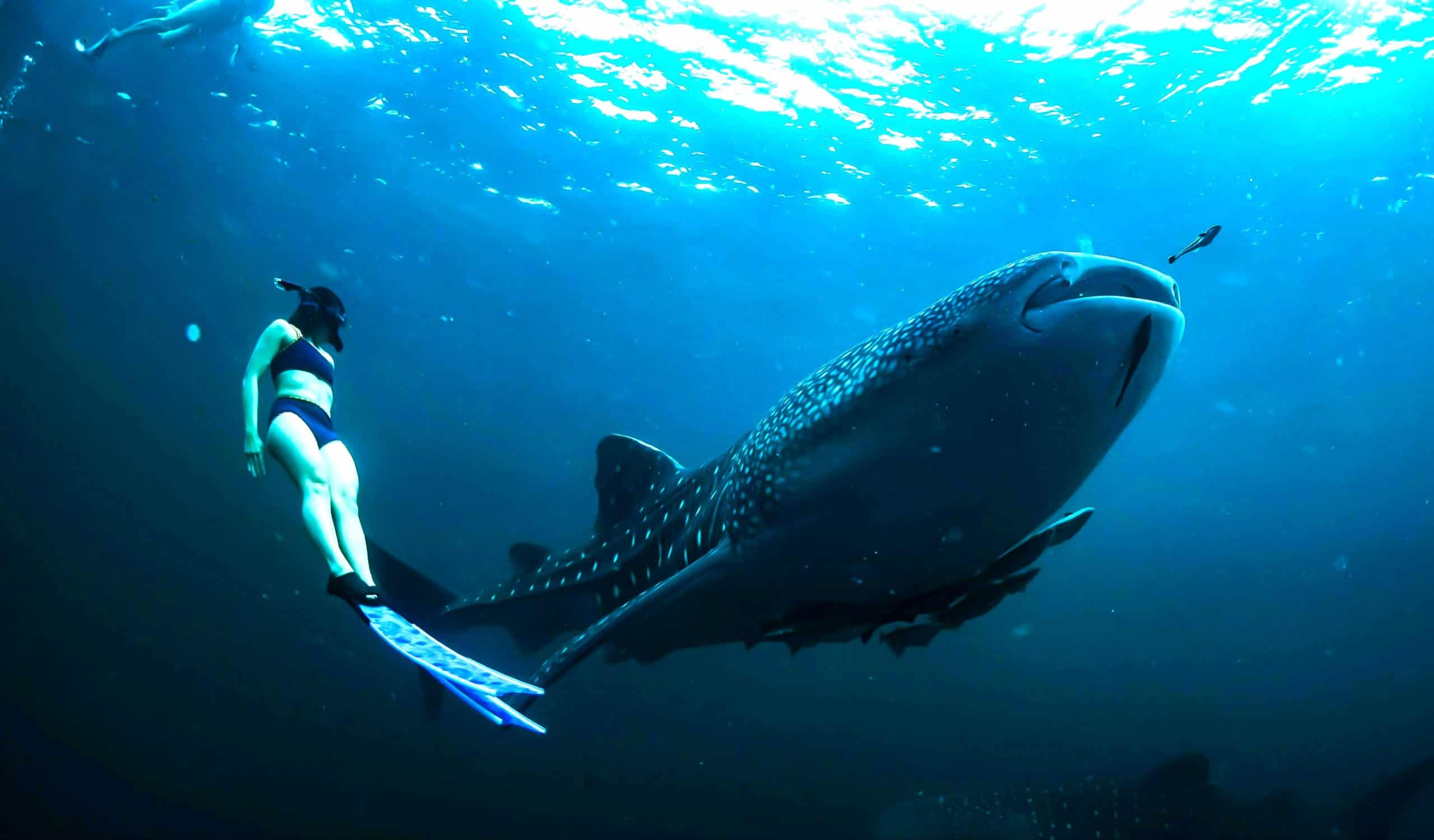
Top 10 Questions and Answers about Swimming with Whale Shark
Swimming with whale sharks is a unique and breathtaking experience that many dream of. Here are the top 10 questions and answers for those considering taking the plunge to swim with these gentle giants.
1. Is it safe to swim with whale sharks?
Answer: Yes, it is generally safe to swim with whale sharks. They are filter feeders and pose no intentional threat to humans. However, it’s important to respect their space and follow the guidelines provided by tour operators to ensure the safety of both swimmers and sharks.
2. Where is the best place to swim with whale sharks?
Answer: There are several great locations around the world, including Oslob in the Philippines, Ningaloo Reef in Australia, La Paz in Mexico, and Tofo Beach in Mozambique. Each location offers a unique experience depending on the time of year and the whale sharks’ migratory patterns.
3. When is the best time to swim with whale sharks?
Answer: The best time varies by location due to different migratory patterns. For example, in the Philippines, whale sharks can be seen year-round but are most commonly spotted from December to May. In Ningaloo Reef, the season runs from March to July.
4. Do I need to be an experienced diver to swim with whale sharks?
Answer: No, you do not need to be an experienced diver. Many tours offer snorkeling opportunities to swim with whale sharks, which requires minimal training. However, being comfortable in the water and having basic swimming skills is important.
5. How close can I get to a whale shark?
Answer: Guidelines typically recommend keeping a distance of at least 3 to 4 meters (10 to 13 feet) from the whale sharks. It’s important to respect these guidelines to avoid disturbing the animals.
6. Can I touch the whale sharks?
Answer: No, touching whale sharks is strongly discouraged and often prohibited. Touching the sharks can remove the protective mucous layer on their skin, making them susceptible to infections and diseases.
7. How do I choose a responsible tour operator?
Answer: Look for operators who follow ethical guidelines, prioritize the well-being of the whale sharks, and contribute to conservation efforts. Research online reviews, ask for recommendations, and inquire about their practices before booking.
8. What should I bring for swimming with whale sharks?
Answer: Essential items include eco-friendly sunscreen, a bathing suit, snorkeling gear (if not provided by the tour operator), and a waterproof camera (without flash) for photos. It’s also a good idea to bring a towel and a change of clothes.
9. Are there age restrictions for swimming with whale sharks?
Answer: Age restrictions can vary by tour operator. Some may have minimum age requirements for children, considering the open water environment and the duration of the boat trip. Always check with the operator ahead of time.
10. How can I contribute to whale shark conservation?
Answer: You can contribute by choosing responsible tour operators, following all guidelines during your swim, educating others about whale sharks, and supporting or donating to conservation organizations dedicated to protecting these magnificent creatures and their habitats.
Swimming with whale sharks is an unforgettable experience that encourages a deeper appreciation for marine life and the importance of conservation efforts. By staying informed and respectful, you can ensure this incredible adventure is positive for both you and the whale sharks.

Swimming With Whale Sharks Complete Guide
Sample Itinerary
Here is a sample itinerary for the Oslob Whale Shark Watching Join In Day Tour from Cebu, providing a guide to the schedule of activities for the day:
- Early pick-up from the hotel
- Light breakfast in Oslob
- Main highlight of the tour: Whale shark watching or snorkeling in the morning
- Cool down and relax at Tumalog Falls
- Lunch at a restaurant, including one round of soft drinks
- Return trip to the city or the hotel
1. Introduction: The Majestic Journey of Swimming with Whale Sharks
Swimming with whale sharks, the gentle giants of the sea, offers an adventure unlike any other. This unique experience, which blends the thrill of being close to one of the largest fish in the world with the serene beauty of tropical waters, has captured the hearts of travelers, adventurers, and marine enthusiasts alike. Among the various destinations across the globe where one can embark on this extraordinary journey, the Philippines, particularly Oslob in Cebu, has emerged as a premier spot for those looking to swim with whale sharks.
The fascination with swimming alongside these majestic creatures is not merely about the thrill. It’s a profound connection with nature, an opportunity to gaze into the peaceful eye of a behemoth that gracefully navigates the ocean’s vastness. The Philippines, with its rich marine biodiversity and warm, crystal-clear waters, offers an unparalleled setting for this interaction. The small coastal town of Oslob, on the island of Cebu, has become synonymous with whale shark tourism, attracting both the seasoned traveler and the digital nomad looking for an unforgettable experience.
Whale sharks, despite their intimidating name, are known for their docile nature, allowing snorkelers and divers to come close, albeit under strictly regulated conditions to ensure the safety of both the sharks and humans. These interactions are not only about the excitement of being in close proximity to such awe-inspiring animals but also serve as a powerful reminder of our responsibility towards marine conservation and the protection of these gentle giants.
The experience of swimming with whale sharks in Oslob and other parts of the Philippines is enriched by the tropical setting — the azure waters, the vibrant coral reefs that lie beneath, and the warm Filipino hospitality that welcomes every visitor. This adventure is more than just a holiday activity; it’s a dive into a world where humans and marine life coexist momentarily in harmony. It’s an adventure that leaves a lasting imprint on one’s soul, changing perceptions and fostering a deeper appreciation for the ocean’s wonders.
Travel channels and vacation blogs often highlight the Philippines as a top destination not only for its beaches and tropical landscapes but also for the unique experiences it offers, such as swimming with whale sharks. Oslob, in particular, has gained fame through travel vlogs and drone videos that showcase the breathtaking beauty of these encounters, drawing in a global audience eager to explore the Philippine waters. The country’s appeal to travelers extends beyond the adventure, attracting digital nomads and expats who wish to blend the thrill of exploration with the tranquility of tropical living.
For those planning to embark on this adventure, it’s not just about jumping into the water. It’s about preparing to meet the ocean’s gentle giants face-to-face, understanding their nature, and recognizing the importance of preserving their habitat. It involves learning about the ethical considerations of wildlife tourism and choosing operators that prioritize the well-being of the whale sharks over profit.
In summary, swimming with whale sharks in the Philippines offers an adventure that is both thrilling and humbling. It’s an opportunity to connect with nature, to explore the depths of the ocean, and to become part of a larger conversation about conservation and responsible tourism. As we dive into the details of this remarkable experience, let’s remember the role we play in ensuring that future generations will also have the chance to swim with the whale sharks in the beautiful, blue waters of the Philippines.
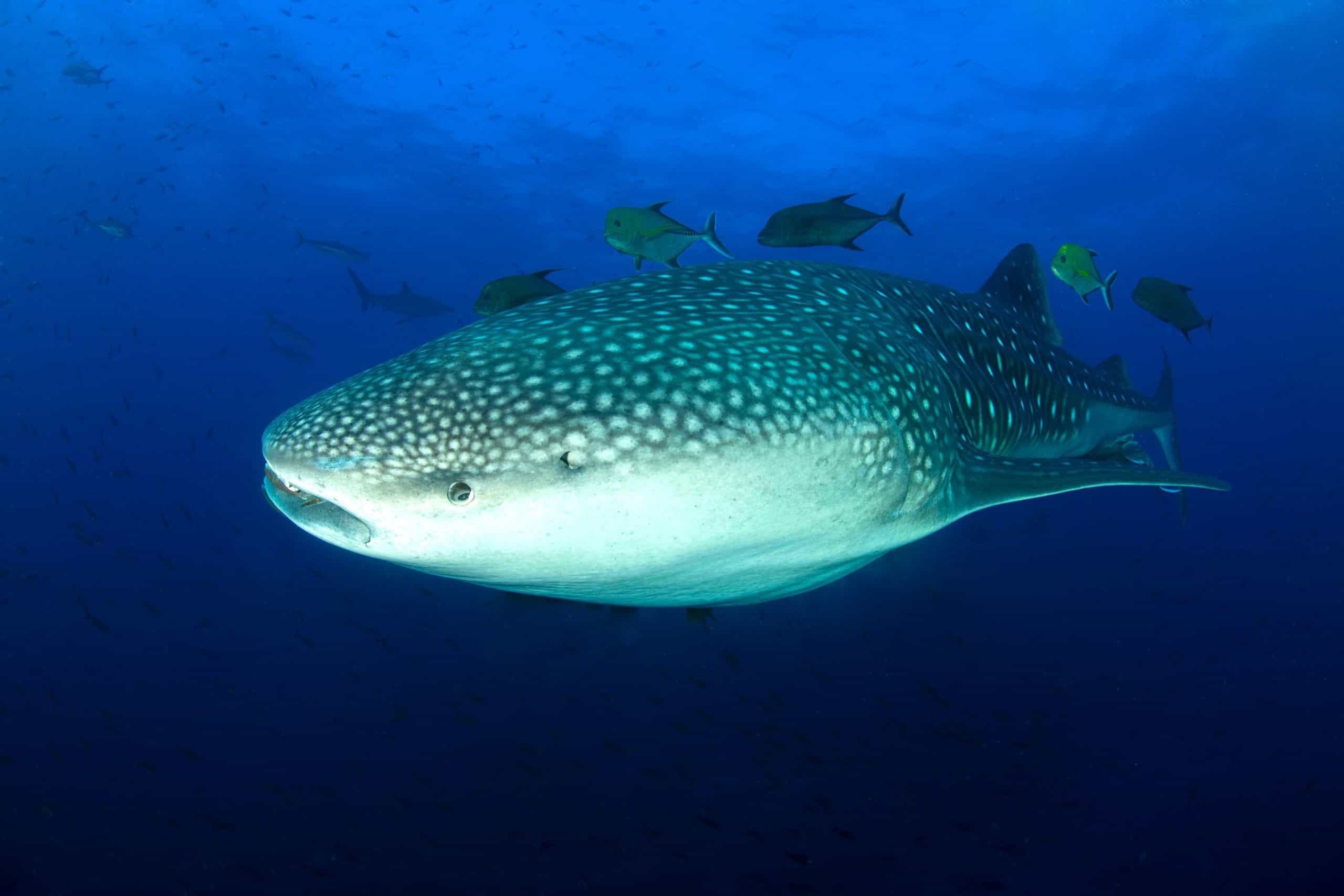
2. Understanding Whale Sharks: The Gentle Giants of the Ocean
Whale sharks, the subject of our fascination and the central figures in the unique experience of swimming with whale sharks, are creatures of majesty and mystery. As we delve deeper into the essence of these marine behemoths, we uncover the myriad aspects that make swimming with whale sharks a bucket-list adventure for many around the globe, especially in the serene waters of the Philippines.
Whale sharks, or Rhincodon typus, hold the title of the largest fish in the ocean, with some individuals growing up to 18 meters (59 feet) in length. Despite their immense size, these gentle giants are filter-feeders, consuming plankton and small fish by filtering water through their wide mouths—a fascinating contrast to the fearsome reputation of sharks in general. This feeding behavior makes swimming with whale sharks in places like Oslob, Cebu, Philippines, not only safe but an ethereal experience, as one witnesses the peaceful nature of these colossal creatures up close.
The whale shark’s skin is another marvel, adorned with a unique pattern of white spots and stripes over a dark gray background, reminiscent of the starry night sky. Each whale shark has its pattern, as distinctive as a human fingerprint, which researchers and conservationists use to identify and track individuals across the world’s oceans. This has led to significant advancements in our understanding of their migration patterns, feeding behavior, and breeding grounds, contributing to the efforts of organizations like the Marine Megafauna Foundation and the World Wildlife Foundation (WWF) in their conservation.
Philippines’ waters, particularly around Oslob, have become a renowned sanctuary where these gentle giants are often encountered, making it a prime spot for swimming with whale sharks. The warm tropical climate, coupled with the abundance of plankton, attracts whale sharks, turning the area into a haven for those looking to experience these magnificent animals in their natural habitat. The interaction between humans and whale sharks in this region has spurred a booming ecotourism industry, highlighting the need for responsible practices that ensure the safety and preservation of whale sharks.
Conservation efforts are paramount when considering swimming with whale sharks. These creatures face threats from commercial fishing, habitat loss, and the impacts of climate change, which affect the availability of their plankton food sources. Through responsible tourism practices, including regulated swimming encounters that minimize stress and disturbance to the animals, we contribute to the sustainable management of whale shark populations. Initiatives like the Wildbook for Whale Sharks, an online photo-identification database, and Ecocean’s research and conservation programs play a crucial role in these efforts, utilizing citizen science to enhance our understanding and protection of whale sharks.
Swimming with whale sharks is more than an adrenaline-fueled adventure; it’s a profound interaction that offers a glimpse into the lives of these mysterious creatures. As we float beside them, observing their graceful movements and the tranquility with which they navigate the vastness of the ocean, we’re reminded of the delicate balance of marine ecosystems and our role in their preservation. This experience not only leaves us with a sense of awe and wonder but also fosters a deeper commitment to marine conservation and the protection of the ocean’s gentle giants.
The allure of swimming with whale sharks in the Philippines is undeniable. From the thrill of encountering these magnificent creatures in the wild to the broader narrative of conservation and respect for marine life, the experience is a mosaic of emotions and learnings. As we venture into these waters, we’re not just seeking an encounter with the largest fish in the sea; we’re stepping into a larger story of ecological awareness, conservation, and the endless wonders that lie beneath the waves.
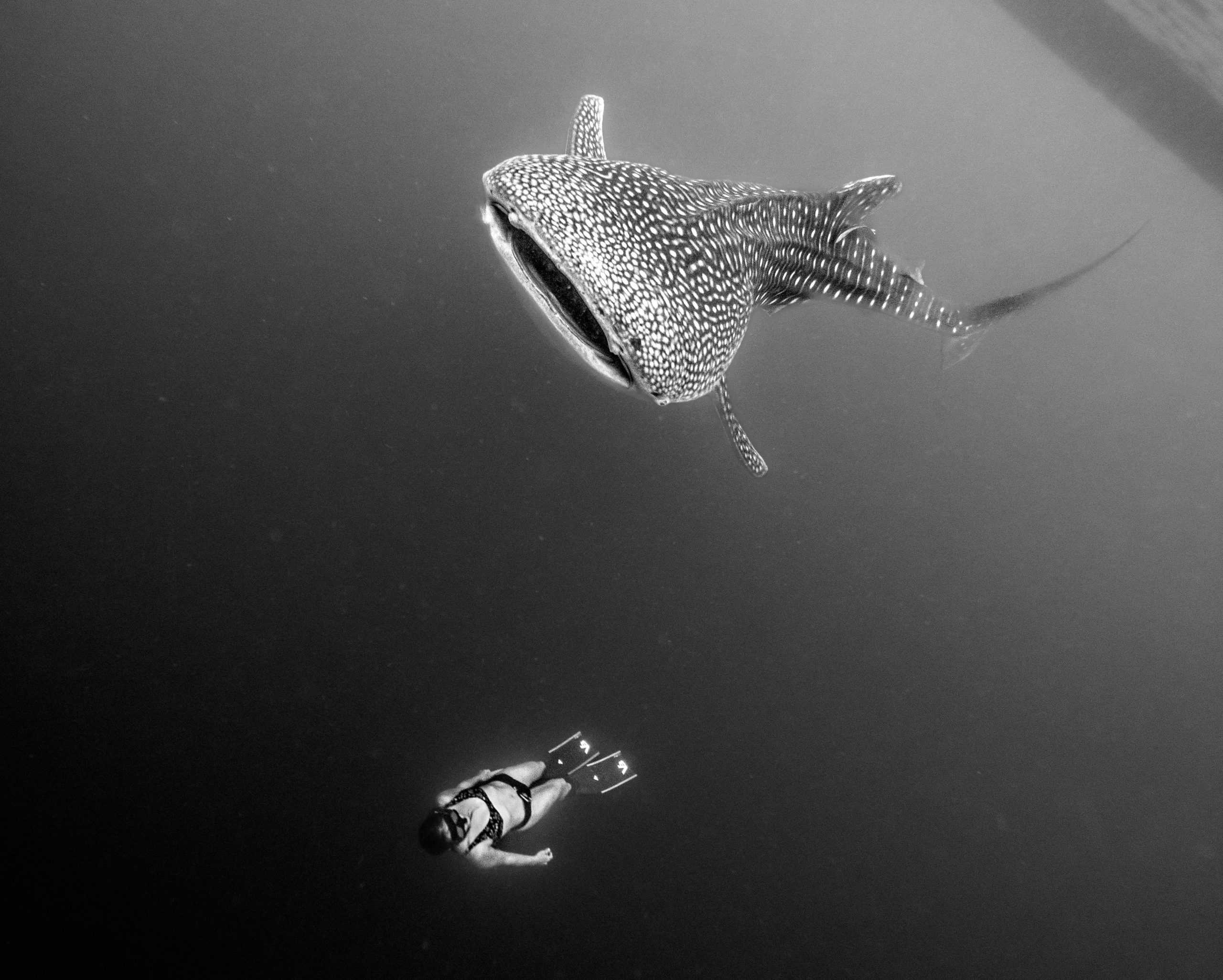
3. Best Destinations for Swimming with Whale Sharks
Swimming with whale sharks is an experience that beckons adventurers and marine enthusiasts to various corners of the globe. However, among the myriad destinations where one can dive into this adventure, the Philippines, with its pristine waters and rich marine biodiversity, stands out as a beacon for those seeking to swim with whale sharks. This section delves into the heart of this magical journey, focusing on the Philippines while touching on other global sanctuaries that offer a rendezvous with these gentle giants.
The Philippines: A Premier Destination
At the forefront of whale shark tourism is the Philippines, a country that has embraced its role as a haven for these gentle giants. Oslob, Cebu, is perhaps the most famous spot in the country for swimming with whale sharks. The warm, nutrient-rich waters of this area offer the perfect conditions for whale sharks, making it an ideal location for those wishing to encounter these creatures in their natural habitat. The visibility here is unparalleled, allowing swimmers and snorkelers clear views of the whale sharks as they gracefully glide through the water.
Oslob’s approach to whale shark interactions is structured to prioritize the safety and well-being of the animals, reflecting the Philippines’ commitment to sustainable and ethical wildlife tourism. By participating in these regulated encounters, visitors not only get to experience the majesty of swimming with whale sharks but also contribute to the local economy and conservation efforts dedicated to preserving these magnificent creatures.
Beyond the Philippines
While the Philippines offers an unrivaled setting for swimming with whale sharks, several other destinations around the world also provide unique opportunities to interact with these oceanic behemoths.
- Isla Mujeres, Mexico: During the summer months, the waters around Isla Mujeres teem with whale sharks, drawing visitors from across the globe. The congregation of whale sharks in this area is one of the largest in the world, offering an exceptional opportunity for swimming and snorkeling with them.
- Ningaloo Reef, Australia: This UNESCO World Heritage Site is another prime location for swimming with whale sharks. The reef’s crystal-clear waters and abundant marine life make it an ideal setting for snorkelers and divers looking to swim alongside these giants.
- Donsol Bay, Philippines: Aside from Oslob, Donsol Bay in the Philippines is renowned for its whale shark sightings. The bay offers a more wild encounter with whale sharks, as it does not feed them to ensure their presence, allowing for a truly natural experience.
- Tofo Beach, Mozambique: Known for its biodiversity, Tofo Beach is a hotspot for marine biologists and snorkelers. The area is not only famous for whale sharks but also for manta rays, offering a double delight for marine wildlife enthusiasts.
- Galapagos Islands, Ecuador: For those seeking an adventure in the Pacific, the Galapagos Islands offer a unique ecosystem with a chance to swim with whale sharks, especially around the northern islands of Wolf and Darwin.
Each of these destinations offers a unique window into the world of whale sharks, highlighting the global efforts to protect and study these magnificent animals. The experience of swimming with whale sharks transcends borders, uniting people in their awe and respect for marine life.
Choosing the Right Destination
When planning to swim with whale sharks, several factors come into play, including the seasonality of sightings, the ethical practices of tour operators, and the overall travel experience. The Philippines, with its blend of accessibility, biodiversity, and commitment to conservation, presents an ideal choice for many. However, the allure of exploring different parts of the world and witnessing the diversity of marine ecosystems also draws travelers to other destinations.
In summary, the journey to swim with whale sharks is one of discovery, not only of the marine giants themselves but also of the diverse marine landscapes our planet offers. Whether in the warm waters of the Philippines or the remote reefs of Australia, each encounter with a whale shark is a reminder of the wonder and fragility of our natural world. As we venture into these waters, we carry with us a responsibility to tread lightly and to contribute to the preservation of these gentle giants for generations to come.

4. Planning Your Adventure: Tips for Swimming with Whale Sharks
Embarking on the journey to swim with whale sharks is an adventure that requires thoughtful planning and preparation. Whether you’re drawn to the crystal-clear waters of Oslob, Cebu, in the Philippines, or another global hotspot for these gentle giants, ensuring a memorable and responsible encounter is paramount. This section offers a comprehensive guide to planning your whale shark adventure, ensuring that from the moment you decide to dive into this experience, every step contributes to an ethical, enjoyable, and unforgettable experience.
Choosing the Best Time to Visit
Timing is crucial when planning to swim with whale sharks. These creatures are migratory, and their presence in certain areas is often dependent on the season and the availability of plankton, their primary food source. In the Philippines, especially in Oslob, whale sharks are present year-round due to the feeding practices that have been established there. However, for a more natural encounter in places where feeding does not occur, such as Donsol Bay, the best time is between November and June, peaking from February to May.
Globally, the timing varies: In Isla Mujeres, Mexico, the whale shark season runs from June to September; in Ningaloo Reef, Australia, it’s from March to July; and in Tofo Beach, Mozambique, while sightings are possible year-round, the peak season is from October to March. Researching the specific timings for whale shark appearances in your chosen destination is essential for increasing your chances of encountering these majestic creatures.
Selecting a Responsible Tour Operator
With the growing popularity of swimming with whale sharks, numerous tour operators offer these experiences. However, not all operators prioritize the welfare of the whale sharks and the environment. Selecting a responsible tour operator is crucial for ensuring that your encounter is ethical and contributes positively to conservation efforts.
Look for operators with certifications or accreditations from recognized environmental organizations. These operators adhere to guidelines that minimize the impact on the whale sharks and their habitats. They ensure that interactions are conducted respectfully, maintaining a safe distance from the animals and avoiding practices that could harm or stress them, such as touching or feeding (outside of established areas like Oslob where feeding is regulated).
Preparing for Your Swim
Swimming with whale sharks is an activity that is accessible to people of all ages and swimming abilities, thanks to the generally calm and shallow waters where these encounters take place. However, some preparation can enhance your experience:
- Snorkeling Skills: While you don’t need to be an expert swimmer, basic snorkeling skills can significantly improve your comfort and enjoyment. Familiarizing yourself with snorkeling gear before your trip can help you focus on the experience rather than adjusting your equipment.
- Underwater Etiquette: Understanding and respecting underwater etiquette is crucial. This includes not touching or chasing the whale sharks and maintaining a respectful distance. Such practices ensure a safe environment for both the swimmers and the sharks.
- Environmental Awareness: Educating yourself about whale sharks and the ecosystems they inhabit can enrich your swimming experience. Awareness of the challenges facing these creatures and their environments can foster a deeper appreciation and a more meaningful encounter.
- Health and Safety: Always consider your health and safety, as well as that of others. Ensure you’re physically fit for the activity and aware of any personal health issues that could be exacerbated by the activity. Listen carefully to the safety briefings provided by your tour operator.
What to Bring
Packing the right items can make your swimming with whale sharks experience smoother and more enjoyable. Essential items include eco-friendly sunscreen, a high-quality underwater camera or GoPro for capturing the moment (while adhering to any guidelines set by your tour operator regarding flash and proximity), and your snorkeling gear, though many operators provide this as part of the tour.
Planning your adventure to swim with whale sharks is the first step towards an unforgettable journey into the world of these gentle giants. By choosing the best time to visit, selecting a responsible tour operator, preparing adequately for your swim, and packing the right items, you’re setting the stage for a life-changing experience. Whether in the vibrant waters of the Philippines or another enchanting destination, swimming with whale sharks is more than an adventure—it’s a privilege and a call to action for the conservation of our planet’s magnificent marine life.
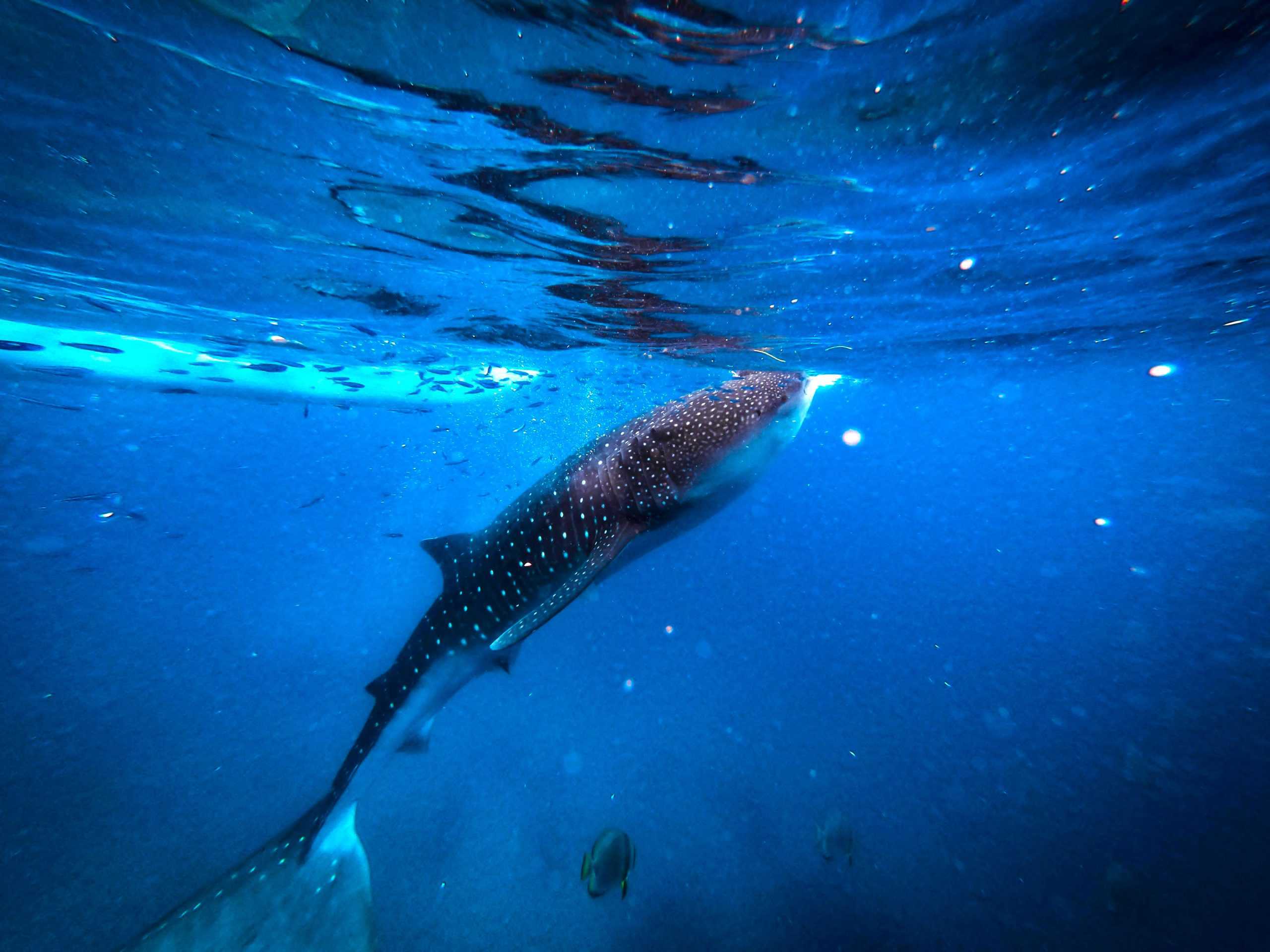
5. The Experience of Swimming with Whale Sharks
The experience of swimming with whale sharks is a profound journey that leaves an indelible mark on the hearts and minds of those fortunate enough to share the water with these magnificent creatures. This chapter delves into what participants can expect when they immerse themselves in the gentle world of the whale shark, particularly in the lush, tropical backdrop of the Philippines, and extends to other vibrant locations around the globe where these gentle giants roam.
The Start of the Adventure
The adventure typically begins at dawn, as the ocean calms and the world beneath the waves awakens. Participants gather, buzzing with anticipation, as guides share crucial briefing information, emphasizing respect, safety, and conservation. The journey to the whale shark’s domain is often short, but it’s packed with scenic beauty and the palpable excitement of the unknown.
As the boat halts and the vast blue expanse unveils itself, the first sight of a whale shark approaching can stir a range of emotions—from awe to a profound sense of humility. These creatures, with their massive size yet gentle demeanor, command a respect that quiets the chatter and hustle of preparation, leaving only the sound of heartbeats and the sea.
Into the Water: The Encounter
Slipping into the water, snorkelers find themselves in a different realm. The proximity to such a colossal being, juxtaposed with its calm, undulating movements, creates a dance of shadows and light beneath the waves. Whale sharks, with their distinctive patterned skin and grandeur, glide effortlessly, their filter-feeding mouths open to the ocean’s bounty.
The experience of swimming alongside these creatures is often described as transcendental. Time seems to stand still, and the usual barriers between human and wildlife dissolve, leaving a connection that is both exhilarating and serene. In the Philippines’ waters, this connection is enhanced by the clarity of the sea and the abundance of life that thrives in these tropical havens.
Swimmers are reminded to maintain a respectful distance, allowing the whale sharks to dictate the encounter’s pace and proximity. This respectful coexistence in the water emphasizes the experience’s ethical aspect, ensuring that the whale sharks feel no distress or compulsion to flee. The result is an encounter that is mutually respectful and profoundly impactful.
Capturing the Moment
While immersed in the experience, many opt to capture the moment through photography or videography. The use of underwater cameras has allowed swimmers to share their encounters with the world, showcasing the beauty and grace of whale sharks. However, the emphasis is always on passive observation, avoiding any disturbance to these majestic beings. The memories created during these encounters often surpass any image, becoming cherished reminders of the privilege of sharing time with the ocean’s gentle giants.
Reflection and Conservation
Emerging from the water, participants often feel a renewed sense of responsibility towards the ocean and its inhabitants. The experience of swimming with whale sharks is not just a thrilling adventure but a powerful lesson in conservation. It serves as a reminder of the fragility of marine ecosystems and the importance of our role in their preservation.
In the Philippines and beyond, the interaction with whale sharks has spurred many to become advocates for marine conservation, supporting efforts to protect these creatures and their habitats. The experience is a catalyst for change, inspiring actions that range from reducing plastic use to supporting marine protected areas and responsible tourism practices.
Swimming with whale sharks is an unforgettable journey that transcends the mere act of snorkeling alongside the largest fish in the sea. It is an immersive experience that connects humans with the majesty of nature, teaching lessons of respect, conservation, and the intrinsic value of all life forms. Whether in the vibrant waters of Oslob, Cebu, or the distant shores of Ningaloo Reef, the encounter with whale sharks remains a profound testament to the beauty and complexity of our planet’s marine life, urging us to protect it for generations to come.
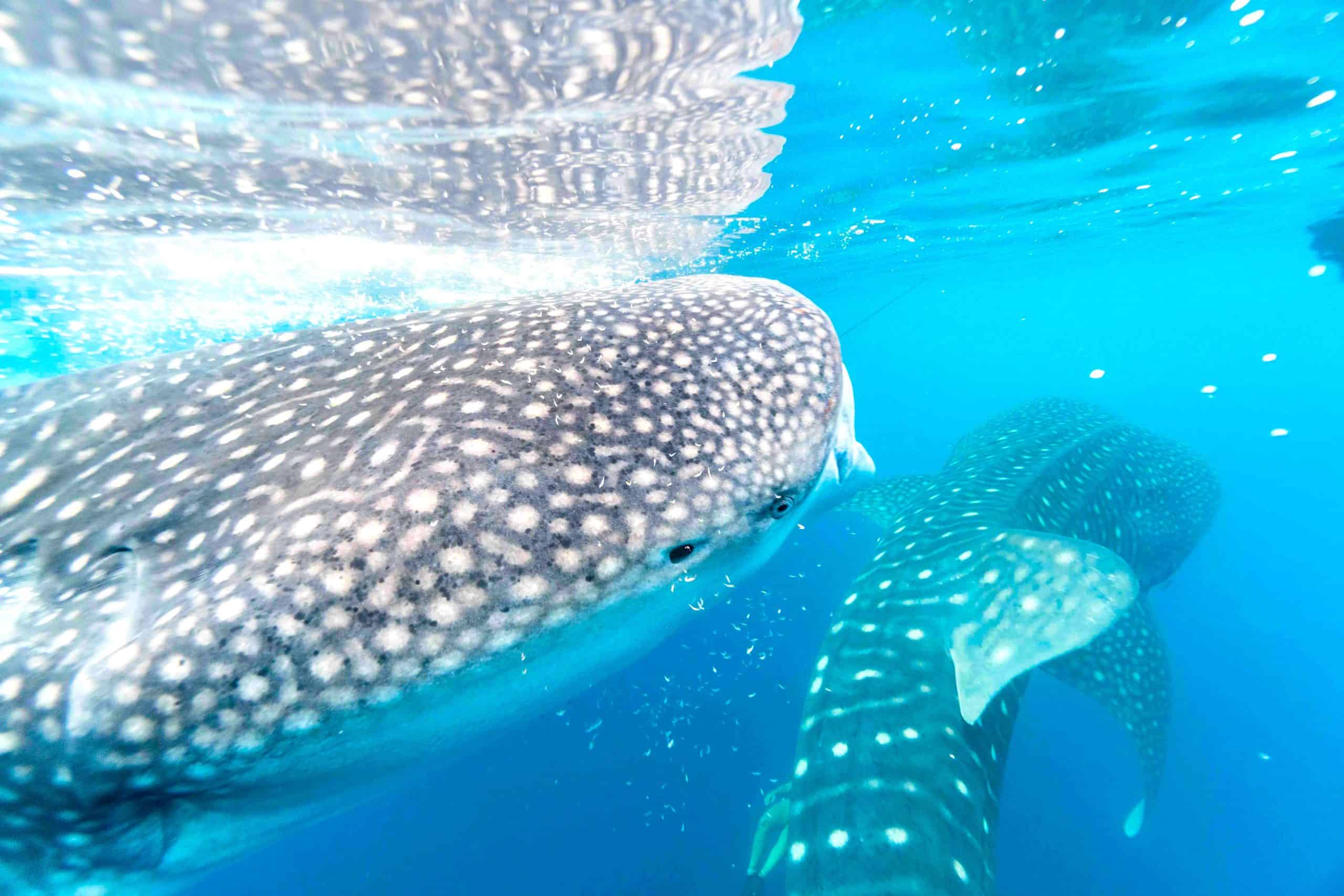
6. Safety Guidelines and Responsible Interaction
Swimming with whale sharks represents a unique intersection of wildlife observation and conservation, where the thrill of close encounters with nature’s giants is tempered by an acute responsibility towards their well-being and habitat preservation. This section outlines the essential safety guidelines and principles for responsible interaction that ensure the sustainability of swimming with whale sharks, particularly emphasizing practices adopted in ecologically sensitive regions like Oslob, Cebu, Philippines, and extending to global standards.
Understanding Whale Shark Behavior
Before delving into the water, understanding whale shark behavior is paramount. Despite their immense size, whale sharks are docile and pose no inherent threat to humans. They are filter feeders, primarily consuming plankton, and are not aggressive. Recognizing these behaviors helps participants maintain a calm demeanor, ensuring a peaceful coexistence during the encounter.
Maintaining a Respectful Distance
One of the cardinal rules of swimming with whale sharks is maintaining a respectful distance—typically advised at 3 to 4 meters away from the animal. This guideline ensures that whale sharks are not startled or disturbed by human presence, allowing them to continue their natural behaviors without stress or agitation. In areas like Oslob, guides and operators enforce this rule diligently, setting an example of how responsible practices can be implemented effectively.
No Touching Policy
The allure of being close to such magnificent creatures can be overwhelming; however, adhering to a strict “no touching” policy is crucial. Human contact can remove the protective mucous layer on the whale shark’s skin, making them susceptible to infections and diseases. Moreover, touching or riding whale sharks can cause them undue stress and potentially alter their natural behaviors or migration patterns.
Minimizing Environmental Impact
Responsible interaction with whale sharks goes beyond direct contact; it also encompasses broader environmental considerations. This includes using eco-friendly sunscreen to avoid contaminating the water with chemicals harmful to marine life and ensuring no litter or plastic waste is left behind. Participants are encouraged to embody principles of ecotourism, where the focus is on conservation, community benefit, and educational outreach.
Adhering to Local Regulations and Guidelines
Different regions have specific regulations and guidelines designed to protect whale sharks and their environments. In the Philippines, for example, the government and local communities have established protocols that regulate the number of visitors, swimming times, and interaction methods with whale sharks. By adhering to these guidelines, participants contribute to a sustainable model that balances tourism with conservation.
Educational Briefings
Before entering the water, participants should undergo educational briefings provided by tour operators. These briefings cover the do’s and don’ts of swimming with whale sharks, safety procedures, and the importance of conservation. They serve as a foundation for respectful and informed interaction, emphasizing the shared responsibility of operators and participants in protecting these gentle giants.
Responsible Photography and Videography
Capturing the moment with photography or videography is a popular aspect of swimming with whale sharks. However, it’s essential to do so responsibly, without flash or intrusive equipment that could distress the animals. Cameras should be used in a way that does not interfere with the whale sharks or other swimmers’ experiences.
Contributing to Conservation Efforts
Participation in whale shark tourism comes with an opportunity to contribute to conservation efforts. Many operators in the Philippines and other parts of the world allocate a portion of their proceeds to marine conservation projects, research, and local community development. By choosing responsible operators, participants can ensure that their experience also supports the long-term preservation of whale sharks and their habitats.
Swimming with whale sharks is an awe-inspiring experience that brings humans into close contact with one of nature’s most majestic creatures. Adhering to safety guidelines and principles of responsible interaction ensures that this unique activity remains a source of wonder and education for future generations. By fostering an environment of respect, conservation, and sustainability, we can continue to marvel at the beauty of whale sharks while ensuring their protection and the health of our oceans.
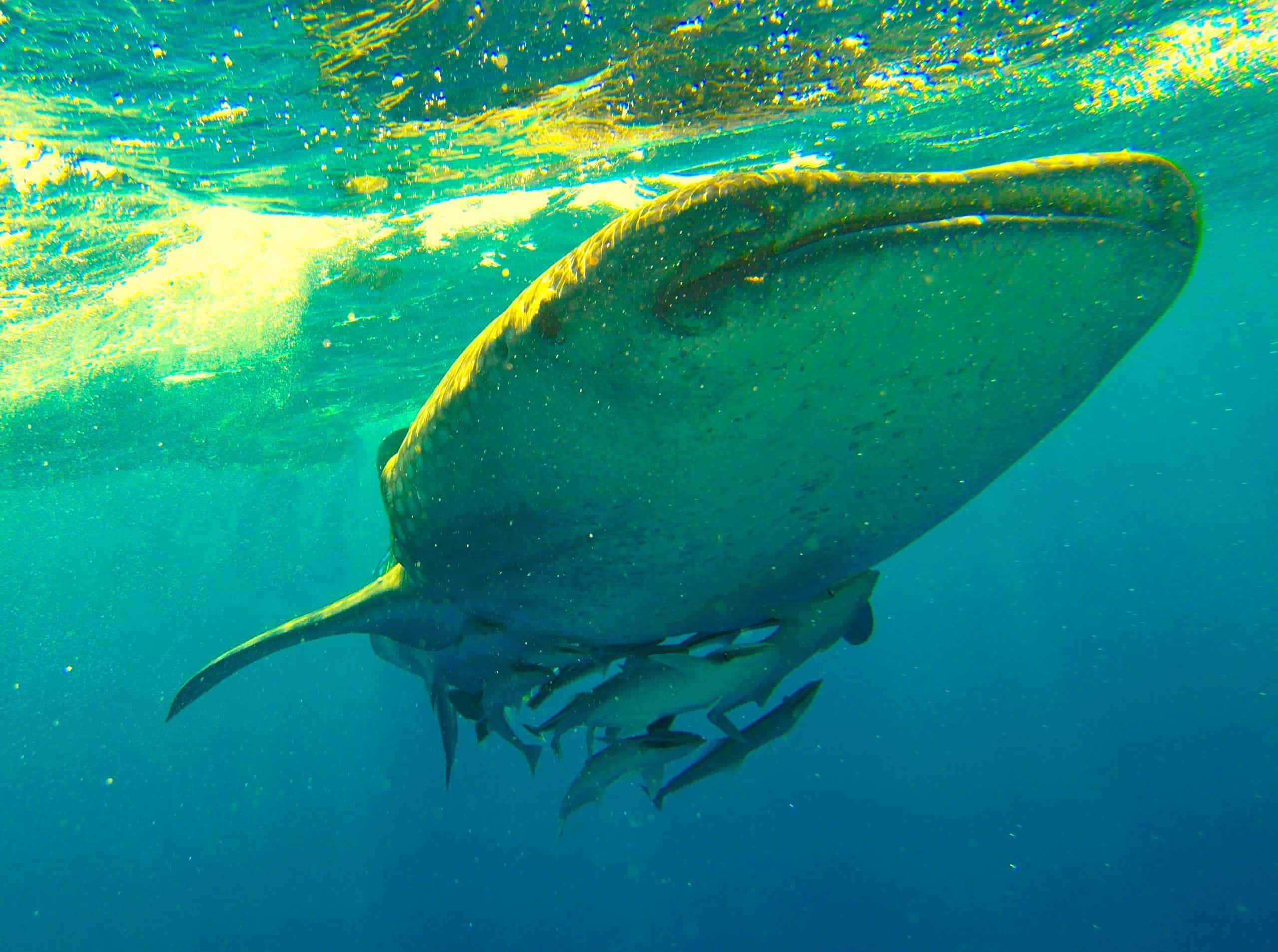
7. Conservation Efforts and Ethical Considerations
In the realm of marine tourism, swimming with whale sharks has emerged as a coveted experience, drawing enthusiasts from around the globe to the tranquil waters of destinations like Oslob, Cebu, in the Philippines. However, the increasing popularity of these interactions brings to the forefront the critical importance of conservation efforts and ethical considerations, ensuring that the awe-inspiring encounters with the ocean’s gentle giants are sustainable and beneficial to both humans and whale sharks.
The Crucial Role of Conservation
Whale sharks, despite their vast size and seemingly unchallenged presence in the oceans, are classified as endangered. Their survival is threatened by a myriad of factors, including but not limited to accidental catches in fishing gear, impacts of marine tourism, and the changing climate affecting their food sources. Conservation efforts aimed at protecting these magnificent creatures are multifaceted, involving research, regulation, and community engagement.
Research and Monitoring
Understanding the migration patterns, breeding grounds, and feeding behavior of whale sharks is essential for their conservation. Organizations like the Marine Megafauna Foundation and the World Wildlife Foundation (WWF), along with initiatives like the Wildbook for Whale Sharks, engage in tagging and monitoring programs. These efforts provide invaluable data that help shape conservation strategies and policies at both local and international levels.
Regulated Interactions
The foundation of ethical swimming with whale sharks rests on regulated interactions that prioritize the well-being of the animals. In the Philippines, guidelines stipulate a minimum distance between humans and whale sharks, limiting the number of swimmers in the water and prohibiting touching or feeding the sharks in ways that alter their natural behavior. These regulations are designed to minimize stress and health risks to the whale sharks, ensuring that tourism does not impede their natural life cycles.
Community Involvement
Local communities play a pivotal role in the conservation of whale sharks. In places like Oslob, the transition from fishing communities to conservation-focused tourism has provided alternative livelihoods that benefit both people and whale sharks. Educating and involving local residents in conservation efforts are vital, as their support and cooperation are crucial for the success of protective measures and sustainable tourism practices.
Ethical Considerations in Marine Tourism
Ethical considerations in swimming with whale sharks extend beyond the immediate interactions. Tourists and operators alike must contemplate the long-term impacts of their activities, choosing practices that support the health of marine ecosystems. This includes selecting eco-friendly travel options, minimizing waste, and choosing tour operators who reinvest in local communities and conservation projects.
The Impact of Global Initiatives
Global initiatives aimed at protecting whale sharks and their habitats contribute significantly to conservation efforts. International agreements and collaborations, such as those under the Convention on International Trade in Endangered Species (CITES) and the Convention on Migratory Species (CMS), help regulate trade and promote the global conservation of whale sharks. Participation and compliance with these agreements by countries hosting whale shark tourism are crucial for the global effort to protect these animals.
The Role of Tourists in Conservation
Tourists have a powerful role to play in the conservation of whale sharks. By choosing responsible tour operators, adhering to guidelines during interactions, and spreading awareness of the importance of whale shark conservation, each visitor contributes to the overarching goal of sustainable coexistence with these marine giants. Moreover, tourists can support conservation directly through donations or indirectly by patronizing businesses that practice ethical tourism.
Swimming with whale sharks is an unparalleled experience that, when conducted responsibly, can contribute to the broader goals of marine conservation and sustainable tourism. As this activity continues to gain popularity, the collective efforts of researchers, conservationists, local communities, tourists, and regulatory bodies will be paramount in ensuring that future generations will also have the opportunity to encounter these gentle giants of the ocean. Through education, regulation, and ethical engagement, the majestic whale shark can continue to thrive in the world’s oceans, inspiring awe and respect in the hearts of those who swim alongside them.
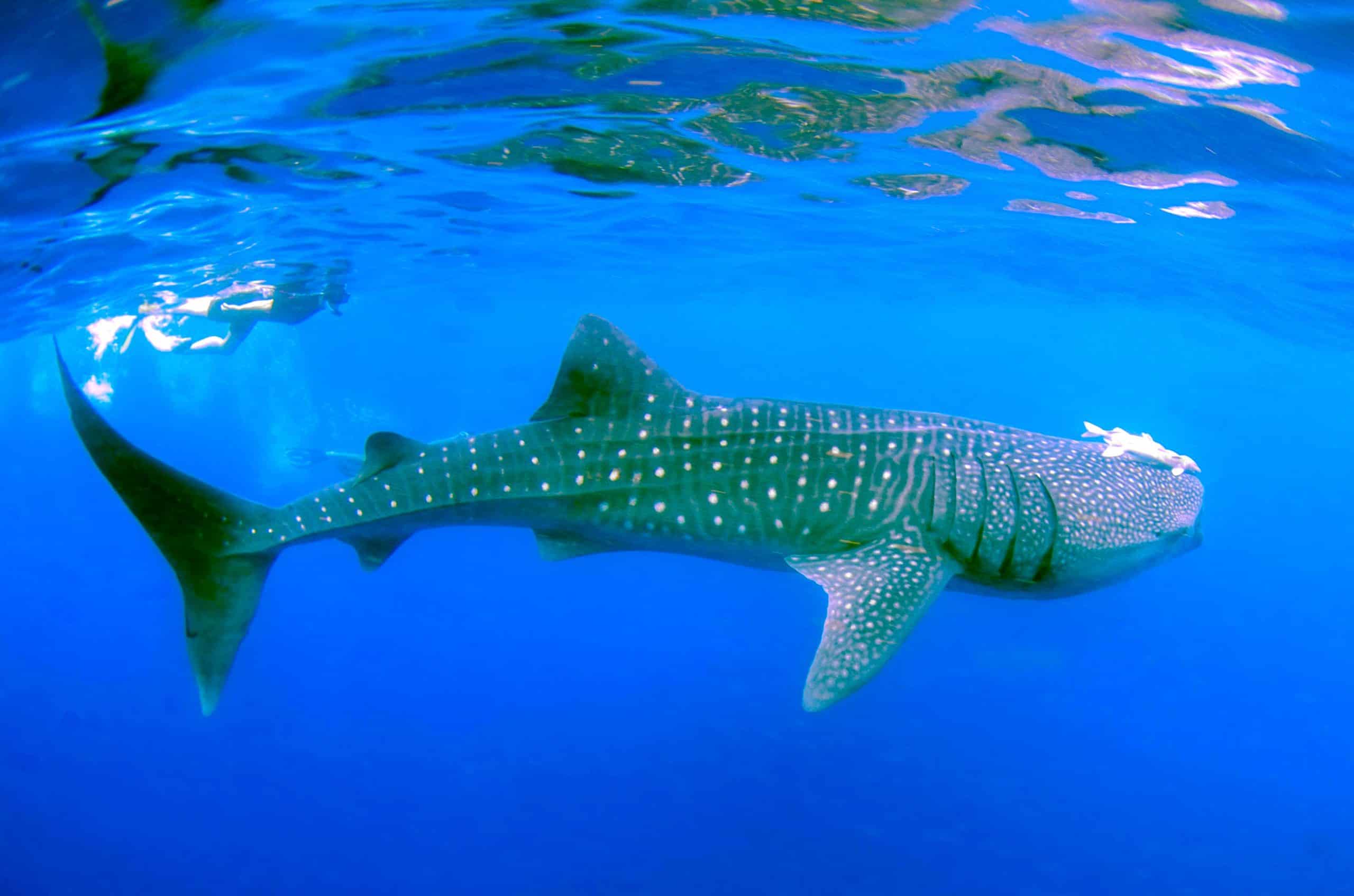
8. How to Contribute to Marine Conservation
Swimming with whale sharks is not just an opportunity for an unforgettable encounter with the ocean’s gentle giants; it’s also a profound moment to reflect on our relationship with the marine environment and how we can contribute to its preservation. As individuals, our actions before, during, and after such an experience can have a significant impact on marine conservation efforts. This section explores how participants in whale shark swims, especially in biodiverse havens like Oslob, Cebu in the Philippines, can actively contribute to the conservation of marine life and promote the health of our oceans.
Responsible Tourism Practices
Choosing responsible tourism practices is the first step toward contributing to marine conservation. This involves selecting tour operators who are committed to ethical guidelines, including those that limit interactions with whale sharks to minimize stress and disruption to their natural behaviors. By supporting businesses that prioritize the welfare of wildlife and the environment, tourists can drive demand for responsible tourism and encourage more operators to adopt sustainable practices.
Educational Engagement
Educating oneself and others about the importance of marine conservation and the specific challenges facing whale sharks is crucial. Many conservation organizations and tour operators offer educational programs that highlight the ecological role of whale sharks, the threats they face, and the measures needed to protect them. Engaging with these programs not only enriches the swimming experience but also equips individuals with knowledge that can be shared within their communities, spreading awareness and fostering a broader culture of conservation.
Supporting Research and Conservation Projects
Many organizations dedicated to marine conservation rely on donations and volunteer support to continue their work. Tourists can contribute by donating to reputable organizations that focus on research, habitat protection, and policy advocacy for whale sharks and other marine species. Additionally, participating in citizen science projects, such as photographing whale sharks for identification and tracking studies, can provide valuable data to researchers working to understand and protect these animals.
Adopting Sustainable Habits
The health of the marine environment is influenced by our everyday actions, even when we’re far from the ocean. Adopting sustainable habits, such as reducing plastic use, choosing sustainable seafood, and supporting policies and initiatives that protect marine ecosystems, can have a positive impact on the ocean’s health. These actions help reduce pollution, overfishing, and other threats to marine life, contributing to a healthier environment for whale sharks and countless other species.
Promoting Ethical Interaction Standards
As individuals share their experiences of swimming with whale sharks on social media and within their networks, they have the power to promote ethical interaction standards. Highlighting the importance of following guidelines, choosing responsible operators, and respecting wildlife can influence others to make conservation-minded choices in their travels. This collective shift toward ethical tourism can drive change in the industry, prioritizing the well-being of marine life over commercial gain.
The privilege of swimming with whale sharks comes with a responsibility to contribute to the preservation of these magnificent creatures and their habitat. Through responsible tourism practices, educational engagement, support for conservation efforts, adoption of sustainable habits, and promotion of ethical standards, individuals can play a vital role in marine conservation. As we marvel at the beauty and majesty of whale sharks in the waters of the Philippines and beyond, let us also commit to actions that ensure their survival and the health of our oceans for generations to come.

9. Living the Digital Nomad Lifestyle: Combining Work and Adventure
In an era where the boundaries between work and leisure blur, the digital nomad lifestyle has emerged as a beacon of possibility for those seeking to meld their professional endeavors with their thirst for adventure. Among the myriad experiences that epitomize this harmonious blend, swimming with whale sharks in tropical destinations like the Philippines stands out as a pinnacle of adventure that can be seamlessly integrated into the digital nomad lifestyle. This section delves into how digital nomads can combine the thrill of swimming with whale sharks with the practicalities of remote work, offering insights into accommodations, connectivity, and living a balanced life of productivity and exploration.
The Allure of the Philippines
The Philippines, with its pristine beaches, crystal-clear waters, and rich biodiversity, has long been a magnet for adventurers from around the globe. It’s a country where the majestic whale sharks glide through the waters, offering an unparalleled opportunity to commune with nature’s gentle giants. For digital nomads, the Philippines not only promises the adventure of swimming with whale sharks but also serves as an ideal backdrop for remote work, thanks to its vibrant culture, warm hospitality, and increasingly robust digital infrastructure.
Integrating Work and Adventure
The key to successfully combining work and adventure lies in achieving a delicate balance between professional responsibilities and the call of the wild. Digital nomads have the unique advantage of flexible schedules, allowing for early morning swims with whale sharks before the tourist crowds swell, followed by productive work sessions fueled by the inspiration drawn from these encounters. Accommodations equipped with reliable Wi-Fi and comfortable workspaces become crucial in this lifestyle, enabling nomads to transition seamlessly from the exhilaration of the ocean to the focus of their digital endeavors.
Choosing the Right Accommodations
For digital nomads, the choice of accommodations goes beyond comfort and aesthetics; it’s about functionality and connectivity. Resorts and guesthouses that cater specifically to the needs of remote workers are increasingly common in the Philippines. These accommodations offer high-speed internet, communal workspaces, and often organize social and networking events that enrich the nomadic experience. Proximity to prime whale shark swimming spots is an added bonus, minimizing travel time and maximizing the ease with which one can engage in this breathtaking activity.
Staying Connected
Reliable internet connectivity is the lifeline of the digital nomad lifestyle. The Philippines has made significant strides in improving its digital infrastructure, with many coastal areas now boasting impressive connectivity that enables seamless video calls, online collaboration, and access to cloud-based work tools. Mobile hotspots and local SIM cards with generous data packages offer flexibility for those days when work calls from a beachside café or a boat deck, adding a touch of the extraordinary to the mundane tasks of daily work.
The Rhythms of a Nomadic Life
Living as a digital nomad in the Philippines, or any tropical paradise that offers the chance to swim with whale sharks, requires an adaptable approach to work and life. It’s about embracing the unpredictability of adventure – whether it’s an unexpected whale shark sighting that calls for an impromptu snorkeling session or a sudden rainstorm that invites a reflective workday indoors. The rhythm of life here is dictated by nature, the community, and the individual’s own aspirations and responsibilities, creating a lifestyle that is as rewarding as it is challenging.
For those who tread the path of the digital nomad, the world is both an office and a playground, with opportunities for growth and adventure around every corner. Swimming with whale sharks in the Philippines encapsulates the essence of this lifestyle – a reminder that work and wanderlust need not be mutually exclusive. With the right preparations, accommodations, and mindset, digital nomads can thrive in this dynamic equilibrium, leveraging the best of both worlds to forge a life that is as productive as it is picturesque.

10. Swimming with Whale Sharks Around the World: Alternatives to the Philippines
While the Philippines, particularly Oslob in Cebu, is famed for its whale shark encounters, the globe offers other mesmerizing locales where these gentle giants grace the waters. Each destination provides a unique backdrop and experience for swimming with whale sharks, often accompanied by distinct seasonal patterns that dictate the best times for sightings. Exploring alternatives like La Paz, Mexico, and Tofo Beach, Mozambique, unveils the global tapestry of whale shark adventures, each with its allure and offerings.
La Paz, Mexico: A Serene Encounter in the Sea of Cortez
Nestled in the Baja California Peninsula, La Paz is a gateway to the Sea of Cortez, often dubbed “The Aquarium of the World.” The waters here are a sanctuary for marine life, including the peaceful whale shark. From October to April, these colossal creatures frequent the bay, attracted by the nutrient-rich waters that provide ample feeding opportunities.
What sets La Paz apart is the serene, crystal-clear waters, offering visibility that ensures swimmers can admire the whale sharks in all their glory. Regulations in La Paz are stringent, emphasizing eco-friendly interactions that protect these majestic animals. Swimming with whale sharks in La Paz is not just about the thrill; it’s an educational experience, fostering a deeper appreciation for marine conservation.
Tofo Beach, Mozambique: A Wild Adventure in the Indian Ocean
Tofo Beach, with its rustic charm and untouched natural beauty, offers a starkly different ambiance. Here, the Indian Ocean harbors a rich biodiversity, making it a prime spot for whale sharks, particularly from October to March. These months coincide with the plankton blooms, drawing whale sharks closer to the surface and providing spectacular opportunities for encounters.
Swimming with whale sharks in Tofo Beach is akin to stepping into an unscripted adventure. The open ocean experiences allow for natural interactions with these nomadic giants, often leading to spontaneous moments of connection that resonate deeply with swimmers. The region’s commitment to sustainable tourism practices ensures that these encounters are respectful and mindful of the whale sharks’ well-being.
Seasonal Sightings and Unique Experiences
The seasonal nature of whale shark sightings adds an element of anticipation and planning to the adventure. In La Paz, the winter months bring cooler waters and an influx of whale sharks, while Tofo Beach’s summer aligns with the whale sharks’ search for plankton. These patterns remind us of the intricate dance between marine life and their environments, emphasizing the importance of responsible tourism practices that honor these natural cycles.
Each location offers a unique lens through which to experience swimming with whale sharks. Whether it’s the tranquil bays of La Paz or the open waters of Tofo Beach, the essence of these encounters lies in the profound connection forged between humans and nature. Beyond the thrill of swimming alongside the largest fish in the sea, these experiences serve as a powerful call to action for the conservation of our oceans and their inhabitants.
Exploring the world’s oceans in search of whale shark encounters reveals the vast and varied stages upon which these gentle giants perform. From the serene waters of La Paz, Mexico, to the wild shores of Tofo Beach, Mozambique, each destination offers a unique adventure that beckons the eco-conscious traveler. As we venture into these aquatic realms, we’re reminded of the delicate balance that sustains marine life and the role we play in its preservation. Swimming with whale sharks, regardless of the location, is an invitation to witness the majesty of nature, inspiring ongoing efforts to protect these magnificent creatures and their habitats.
11. Practical Information for Travelers
Embarking on the journey to swim with whale sharks, especially in renowned locations like Oslob, Cebu, Philippines, is an adventure that requires careful planning and preparation. This section aims to equip travelers with essential practical information, ensuring that their experience is not only unforgettable but also seamless and respectful of the marine environment.
Choosing the Right Season
Timing your visit is crucial for maximizing the chances of swimming with whale sharks. In Oslob, as well as in many other destinations worldwide, the presence of whale sharks can be seasonal, largely dependent on factors such as water temperature and food availability. Generally, in the Philippines, whale shark sightings are most common from November to May, peaking around March and April. However, Oslob offers year-round opportunities due to the unique feeding practices in the area. Always check local guidelines and recommendations to plan your trip during optimal sighting periods.
Booking with Responsible Operators
Selecting a tour operator committed to ethical practices and conservation is vital. Look for operators who have established guidelines for interactions with whale sharks, including restrictions on touching and maintaining a safe distance. Responsible operators will also have knowledgeable guides who provide briefings on how to interact with the animals properly and may contribute to conservation efforts or local community projects. Researching and booking in advance can secure your spot with a reputable provider, especially during peak seasons.
What to Pack
Preparing the right gear can enhance your swimming experience. Essential items include:
- Eco-friendly sunscreen: To protect your skin while minimizing harm to marine life.
- Snorkeling equipment: While many operators provide gear, bringing your own can ensure a comfortable fit and a better experience.
- Waterproof camera: For capturing the majestic beauty of whale sharks. Remember to adhere to guidelines regarding flash and proximity to the animals.
- Reusable water bottle: Staying hydrated is key, and using a reusable bottle helps reduce plastic waste.
Health and Safety
Ensuring your physical readiness and understanding health and safety guidelines are paramount. If you have limited swimming or snorkeling experience, consider practicing before your trip. Be aware of the physical demands and ensure you’re comfortable in open water. Listen attentively to safety briefings and respect the guidelines set by your tour operator to ensure a safe experience for both you and the whale sharks.
Local Etiquette and Customs
Respecting local customs and practices is part of being a responsible traveler. In the Philippines, a friendly and respectful demeanor goes a long way. Learning a few basic phrases in the local language can enhance your interaction with the community. Additionally, supporting local businesses by purchasing local products or dining at local eateries can contribute positively to the area’s economy.
After the Swim: Contributing to Conservation
Your journey doesn’t end after you step out of the water. Sharing your experience responsibly, advocating for marine conservation, and supporting organizations dedicated to protecting whale sharks can extend the impact of your trip. Consider donations or volunteer opportunities with conservation groups and use your platform, no matter how big or small, to spread awareness about the importance of protecting these gentle giants and their habitats.
12. Health and Safety Precautions
Swimming with whale sharks is more than an entry on a bucket list; it’s a privilege that comes with responsibilities. By preparing thoroughly, choosing ethically minded operators, respecting local cultures, and contributing to conservation efforts, travelers can ensure that their encounters with these majestic creatures are both personally transformative and beneficial to the whale sharks and their environment.
The awe-inspiring experience of swimming with whale sharks, a must-do for many adventurers flocking to destinations like Oslob, Cebu, in the Philippines, and other renowned global spots, necessitates a paramount consideration for health and safety precautions. Both for the swimmers and the majestic whale sharks, ensuring a safe encounter is crucial. This section delves into the essential health and safety measures every traveler should consider to ensure the encounter is not only exhilarating but also conducted within the safest parameters possible.
Physical Fitness and Swimming Skills
Before planning to swim with whale sharks, evaluating your physical fitness and swimming skills is essential. While you don’t need to be an Olympic swimmer, comfort in open water and basic snorkeling proficiency can significantly enhance your experience. If your swimming skills are rusty or if you’re not used to snorkeling, consider taking a few lessons or practicing in a controlled environment before your trip. This preparation ensures you can focus on the experience rather than struggling with the basics of swimming or snorkeling.
Understanding Ocean Conditions
Ocean conditions can vary greatly, even within the same location, depending on the weather and time of day. It’s vital to have a basic understanding of these conditions and to heed local advice and warnings. Currents, visibility, and water temperature can affect your ability to swim comfortably and safely with whale sharks. Always listen to your guide or tour operator, as they are best placed to assess daily conditions and make informed decisions about entering the water.
Health Considerations and Insurance
Before embarking on a trip to swim with whale sharks, assessing any health conditions that could be exacerbated by the activity is crucial. Conditions such as asthma, heart problems, or severe allergies should be discussed with a healthcare provider to determine if swimming in open water is advisable. Moreover, ensuring you have adequate travel insurance that covers activities like swimming with whale sharks can provide peace of mind, covering unexpected medical expenses or the need for emergency services.
Safety Briefings and Guidelines
Participating in safety briefings provided by your tour operator is not optional—it’s an essential part of the experience. These briefings cover critical aspects of the encounter, including how to safely enter and exit the water, how to use snorkeling equipment properly, and how to interact with whale sharks without causing them stress or harm. Paying close attention and adhering to these guidelines ensures a safe experience for everyone involved.
Respecting Wildlife
The safety of the whale sharks is just as important as that of the humans swimming with them. Maintaining a respectful distance, refraining from touching the sharks, and avoiding obstructing their path are all part of responsible wildlife interactions. Remember, the goal is to observe these incredible creatures in their natural habitat without impacting their well-being negatively.
Emergency Preparedness
Finally, understanding the emergency procedures in place by your tour operator can enhance safety during the swim. Knowing the location of safety equipment on the boat, the emergency signals used by guides, and the protocol for getting help if needed can make all the difference in ensuring a safe and enjoyable experience.
Swimming with whale sharks offers a unique and profound connection to the marine world, blending the thrill of close encounters with a deep respect for nature’s marvels. By prioritizing health and safety, both for swimmers and the whale sharks, we can ensure that this extraordinary experience remains available and enjoyable for future generations. Adhering to the outlined precautions and guidelines guarantees that your adventure in the waters of the Philippines or any other global destination is memorable for all the right reasons.
13. Frequently Asked Questions
Embarking on an adventure to swim with whale sharks raises numerous questions, particularly for those new to this extraordinary experience. This section addresses some of the most frequently asked questions by travelers eager to dive into the waters of destinations like Oslob, Cebu, in the Philippines, or other renowned spots worldwide. By addressing these queries, we aim to prepare, inform, and inspire responsible participation in swimming with whale sharks.
Q: Is it safe to swim with whale sharks?
A: Yes, swimming with whale sharks is considered safe for both the swimmers and the sharks when conducted under guided, regulated conditions that prioritize the well-being of the whale sharks. These gentle giants are filter feeders and pose no predatory threat to humans. Adhering to guidelines such as not touching the sharks and maintaining a respectful distance ensures a safe experience for all.
Q: What is the best time of year to swim with whale sharks?
A: The optimal time for swimming with whale sharks varies by location. In Oslob, Cebu, whale sharks can be encountered year-round due to regulated feeding practices that attract them to the area. In other locations, their presence is often seasonal, linked to plankton blooms and water temperatures. Researching your specific destination or consulting with tour operators can provide guidance on the best times for encounters.
Q: Can anyone participate in swimming with whale sharks, or are there age restrictions?
A: While most tour operators welcome participants of all ages, the activity may be subject to restrictions based on swimming ability, health conditions, and safety considerations. It’s essential to check with your chosen operator about any age restrictions or requirements, especially for children, to ensure a safe and enjoyable experience for everyone.
Q: What should I bring for swimming with whale sharks?
A: Essential items include eco-friendly sunscreen, a bathing suit, a towel, and, if desired, your snorkeling gear, though many operators provide this. A waterproof camera or GoPro is also recommended for capturing the experience, keeping in mind to avoid flash and adhere to guidelines on proximity to the sharks.
Q: How can I ensure my interaction with whale sharks is ethical and supports conservation?
A: Choosing a responsible tour operator that adheres to ethical guidelines and supports conservation efforts is crucial. Engage in experiences that respect the natural behaviors of whale sharks, including no touching and maintaining a safe distance. Additionally, participating in educational programs and contributing to conservation initiatives can enhance the positive impact of your encounter.
Q: Are there any health considerations I should be aware of before swimming with whale sharks?
A: Participants should be in good physical health and comfortable swimming in open water. If you have any medical conditions or concerns, it’s advisable to consult with a healthcare provider before participating. Being transparent with your tour operator about any health issues can also ensure that necessary precautions are taken for a safe experience.
Q: How does swimming with whale sharks contribute to their conservation?
A: When managed responsibly, swimming with whale sharks can contribute to conservation through awareness, education, and the generation of funds that support research and protective measures. Engaging in these experiences with a conservation-minded approach can foster a deeper appreciation for marine life and inspire ongoing support for oceanic preservation efforts.
Swimming with whale sharks is an encounter that touches the soul, offering a glimpse into the majesty of the marine world and highlighting the importance of our role in its preservation. By seeking answers, making informed choices, and approaching these experiences with respect and mindfulness, each swimmer can contribute to the ongoing story of conservation and coexistence with the ocean’s gentle giants.
14. The Transformative Experience of Swimming with Whale Sharks
The opportunity to swim with whale sharks, the gentle leviathans of the sea, offers a profound and transformative experience that resonates deep within the souls of those who venture into their domain. This section delves into the myriad ways in which swimming with these magnificent creatures in places like Oslob, Cebu, Philippines, and other prime global locations, can alter perceptions, inspire conservation efforts, and foster a deeper connection with the natural world.
A Moment of Awe and Humility
The first encounter with a whale shark, with its massive size dwarfing human swimmers, instills an immediate sense of awe and humility. This majestic presence, coupled with the serene grace with which whale sharks glide through their aquatic realm, serves as a powerful reminder of the vastness and beauty of the natural world and our small place within it. The experience challenges the swimmers to reconsider their relationship with nature, promoting a mindset of stewardship and respect for marine life.
Inspiration for Conservation
Swimming with whale sharks transcends mere recreation; it serves as a poignant education in the importance of marine conservation. Witnessing these creatures up close, understanding the threats they face, and recognizing their significance within the ocean’s ecosystem, can turn participants into advocates for marine conservation. This transformative effect inspires individuals to engage in or support efforts to protect whale sharks and their habitats, whether through direct action, financial contributions to conservation projects, or simply by raising awareness within their communities.
A New Perspective on Adventure and Travel
For many, the experience of swimming with whale sharks reshapes their approach to adventure and travel. It emphasizes the value of experiences that offer not only personal enrichment but also contribute positively to the environment and local communities. Travelers increasingly seek out destinations and activities that align with ethical and sustainable practices, favoring those that allow for respectful wildlife encounters and support conservation initiatives.
The Emotional Impact
The emotional impact of swimming with whale sharks can be profound and lasting. For some, the encounter evokes a sense of peace and connectedness with nature that is deeply healing. For others, it may spark a passion for marine biology, ecology, or environmental activism. The experience often leaves an indelible mark, fueling a lifelong interest in and commitment to the oceans and their inhabitants.
Fostering Global Connections
Swimming with whale sharks also highlights the interconnectedness of our global ecosystems and the shared responsibility to protect them. It brings together people from diverse backgrounds and cultures with a common purpose and passion, fostering a sense of global community and cooperation in the face of environmental challenges.
The experience of swimming with whale sharks is much more than a tick on a bucket list; it is a gateway to transformation. It offers a unique blend of awe, education, emotional impact, and a renewed sense of purpose. Those who have had the privilege of sharing the water with these gentle giants carry forward not just memories, but a changed outlook on life, a deeper appreciation for the natural world, and a renewed commitment to its preservation. In the serene and vibrant waters of the Philippines and beyond, swimming with whale sharks remains an unparalleled experience that continues to inspire and transform the lives of those who dare to dive into the unknown.
15. Beyond the Encounter: Continuing the Journey of Conservation
The journey of swimming with whale sharks, particularly in biodiverse sanctuaries like Oslob, Cebu, in the Philippines, often marks the beginning of a deeper, lifelong engagement with marine conservation for many. This transformative experience illuminates the intricate connections between individual actions and the broader health of our planet’s marine ecosystems. As we delve into the continuation of this journey beyond the initial encounter, it becomes evident that the true essence of swimming with whale sharks lies in the ripple effects of awareness, advocacy, and action that it inspires.
Cultivating Awareness and Advocacy
Post-encounter, individuals frequently find themselves endowed with a renewed sense of purpose and a compelling drive to advocate for the oceans and their inhabitants. The firsthand experience of the serene grandeur of whale sharks catalyzes a deeper understanding of the fragility of marine life and the threats it faces, from climate change and pollution to unsustainable fishing practices. Armed with this knowledge, former swimmers often transition into passionate advocates, utilizing their platforms—be it social media, community forums, or personal networks—to disseminate information and galvanize support for marine conservation initiatives.
Engagement with Conservation Projects
The inspiration drawn from swimming with whale sharks frequently motivates individuals to support or engage with conservation projects directly. This engagement can take various forms, from volunteering for beach clean-ups and participating in citizen science projects to financially supporting organizations dedicated to marine research and the protection of endangered species. By contributing their time, energy, and resources, individuals can play a pivotal role in advancing the science and conservation efforts critical to understanding and protecting whale sharks and their habitats.
Adopting Sustainable Practices
The encounter with whale sharks often serves as a catalyst for individuals to evaluate and modify their lifestyle choices in favor of more sustainable practices. Recognizing the impact of plastic pollution, overfishing, and carbon emissions on the marine environment, individuals are motivated to adopt changes such as reducing single-use plastics, choosing sustainable seafood, and minimizing their carbon footprint. These personal actions, while seemingly small in isolation, collectively contribute to the larger effort to mitigate human impact on the oceans.
Fostering Community Involvement
The transformative experience of swimming with whale sharks does not exist in a vacuum; rather, it has the potential to inspire community-level involvement in conservation efforts. By sharing their experiences and the lessons learned, individuals can encourage others within their communities to participate in conservation activities, support sustainable tourism, and advocate for policies that protect marine ecosystems. Community involvement amplifies the impact of conservation efforts, creating a stronger, unified force for positive change.
Supporting Ethical and Sustainable Tourism
Finally, individuals who have swum with whale sharks are uniquely positioned to promote ethical and sustainable tourism practices. By opting to support tour operators and destinations that prioritize the well-being of wildlife and the environment, travelers can drive demand for responsible tourism. This, in turn, encourages the industry to adopt practices that ensure the long-term sustainability of wildlife encounters, benefiting both the animals and the local communities that depend on them.
The experience of swimming with whale sharks transcends the moments spent in the water alongside these gentle giants. It serves as a profound call to action, urging individuals to continue the journey of conservation long after the encounter has ended. Through awareness, advocacy, direct engagement, sustainable lifestyle choices, and support for ethical tourism, the legacy of swimming with whale sharks can manifest in lasting contributions to the preservation of our planet’s irreplaceable marine ecosystems. This ongoing journey underscores the interconnectedness of all life and the critical role each of us plays in safeguarding the natural world for future generations.
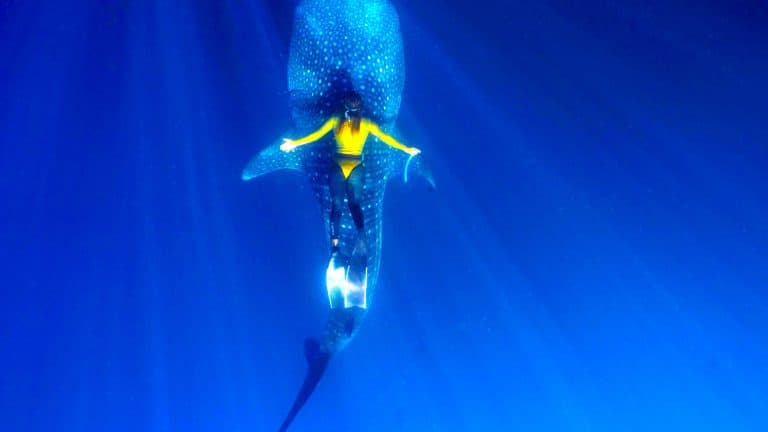













Add comment